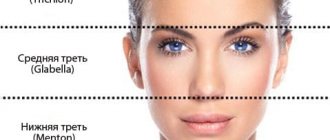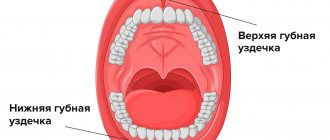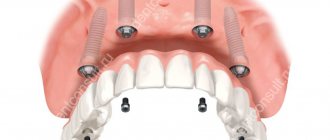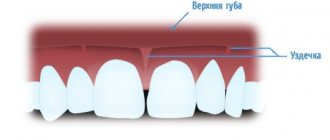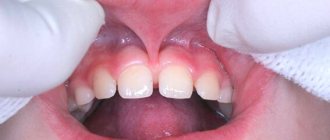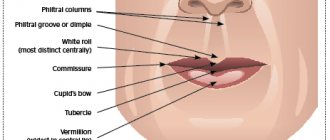This article is devoted to the problem increasing/decreasing the chin protrusion. If you are interested in the question of how to remove a double chin, go to the article “ HOW TO REMOVE A SECOND CHIN“.
Plastic surgery methods (genioplasty or mentoplasty) are used to reduce or enlarge the chin. Chin surgery can help you not only change the size of your chin bump, but also improve its shape. As a result of this operation, you will get a more proportional and beautiful face.
All photos
CHIN PLASTY – ANTI-AGING EFFECT
After chin augmentation surgery, almost all patients note that their face looks not only more beautiful, but also younger. Everything is very simple! The increased size of the chin protuberance compensates for the missing volume of subcutaneous tissue, thanks to which all folds of the skin are straightened, jowls and wrinkles disappear, and the skin under the chin is tightened. But it is also prevention. Let's reveal a secret - people with a small (sloping) chin age earlier and more noticeably.
Chin plastic surgery (especially augmentation mentoplasty) is popular not only among women, but also among men. After all, it’s hard to imagine a man’s face without a beautiful, strong-willed chin.
Chin surgery is often performed simultaneously with rhinoplasty. If a small chin is adjacent to a large nose (the “parrot profile” effect) or the patient does not like the predatory profile with a hooked nose and a protruding chin, a comprehensive correction can be performed. This operation is called profiloplasty. We write about complex chin and nose surgery here.
Chin augmentation can be performed either with or without an implant (due to rotation of the bony protrusion of the chin). And, of course, Dr. Kudinova can not only enlarge, but also (which is much more difficult!) reduce your chin.
Kudinova Ekaterina Sergeevna
Candidate of Medical Sciences, certificates in plastic and maxillofacial surgery. International expert in face and neck lifts, eyelid surgery, eyebrow surgery, chin surgery, etc.
To learn more
IS CHIN PLASTY RIGHT FOR ME?
Indications for chin correction surgery may include:
- An underdeveloped, sloping chin, creating the effect of a small “bird” face;
- A small chin and age-related changes, as a result of which soft tissues slide down, forming “jowls” and a double chin;
- Too large, protruding chin;
- Wide, heavy lower jaw (“horse-like” face);
- Unattractive or asymmetrical chin shape.
To obtain a comprehensive result, chin surgery can be combined with liposuction and neck lift, as well as rhinoplasty.
Results Before and After CHIN PLASTY View now
CHIN PLASTY. METHODS
The following techniques are most often used for surgical correction of the chin:
Chin augmentation with modern implants . This low-traumatic method is indicated for patients with a small, underdeveloped chin who want to achieve more harmonious facial proportions with a clear lower jaw line.
Chin augmentation with your own bone tissue . Small chin augmentation, in which the surgeon moves part of the mental protuberance forward through an osteotomy. This plastic method is used to correct a sloping chin in both men and women.
Chin reduction (reduction mentoplasty) . Correction of a heavy chin, in which the surgeon works with the bone tissue, achieving the desired proportions. Reducing a long chin immediately changes the face, making it graceful and harmonious.
Alternative (non-surgical) methods are chin contouring with natural hyaluronic acid fillers or lipofilling. These methods are indicated if a slight increase in the chin or minor correction of its shape is required.
The choice of chin plastic surgery technique is carried out after a thorough study of the proportions of the face from various angles and other studies.
What are implants made of?
In addition to silicone implants, there are also bioprostheses (based on the patient’s cartilage tissue). Despite the fact that they are as safe as silicone, and therefore are also often used to enlarge the chin, experts note some nuances that can sometimes arise when using them.
“Of course, silicone implants are ideal for chin augmentation, because they do not affect the resorption of bone tissue,” notes Elena Chirikova.
— Silicone elastomer is a semi-soft material, and when changing such an implant, we see the absence of any resorption in the area of the bony part of the chin. If the implant is made of a hard material (for example, a rib), then the bone part of the chin experiences severe pressure from the bioimplant, which forces it to follow the contour of its posterior (facing the bone) part, and the bone part of the chin is resorbed, that is, it loses its own volume.”
HOW IS THE OPERATION FOR SURGICAL CORRECTION OF THE CHIN PERFORMED?
When planning the operation, a thorough comparative analysis of the facial proportions and a comparison of the right and left profiles is carried out. Such an assessment is necessary to ensure that the face after chin surgery looks natural and beautiful from any angle. Then the necessary tests and studies are carried out, including a lateral teleroentgenogram and an orthopantomogram.
Mentoplasty, the price of which varies depending on the chosen surgical technique, is one of the most effective plastic surgery technologies.
Before and After FACE LIFT Results View now
All chin surgeries are performed under general anesthesia and are therefore painless. When performing chin correction surgery, the incision is made in the mouth, in the crease between the lower jaw and lip, so the scar after the operation will not be visible. Chin correction surgery usually takes about 1 hour, but in complex cases, mentoplasty can take longer. If genioplasty is performed in conjunction with other plastic surgeries, such as a facelift or rhinoplasty, the duration of the operation increases to 2-3 hours.
Treatment of skin diseases in children
Since childhood skin diseases occur under the influence of various factors, if a rash appears in a child, visit a dermatologist, he will prescribe tests to identify the causes of the pathology.
To combat dermatosis, drugs are used against the main causative agents of the disease, external agents and tablets are used, the action of which is aimed at eliminating unpleasant manifestations and strengthening the immune system. Physiotherapy - UHF, ultraviolet irradiation, laser therapy - is used as additional treatment methods.
Therapy is carried out at home; in case of chronic skin diseases, children are given vouchers to specialized sanatoriums.
How to treat skin diseases
| Name of the drug | Which group does it belong to? | What is it prescribed for? |
| Viferon, Panavir | Antiviral | For dermatoses of viral origin. |
| Acyclovir | Antiherpes remedy | For infections caused by various types of herpes virus. |
| Collomak, Feresol | Cauterizing agents | Helps remove warts. |
| Lamisil, Ketoconazole, Fluconazole, Nizoral shampoo, Dermazole | Antifungal drugs | For mycoses, seborrhea. |
| Tetracycline, Erythromycin | Antibiotics | For purulent lesions, secondary infections due to scratching of the rash. |
| Medifox, Benzyl benzoate, sulfur ointment | Acaricidal drugs | For scabies. |
| Pediculen Ultra, Nyx | Anti-pediculosis drugs | For pediculosis. |
| Trichopolum, Metronidazole | Antiprotozoal agents | With demodicosis |
| Zyrtec, Cetrin | Antihistamines | Prescribed for all types of dermatoses to eliminate itching and swelling. |
| Prednisolone, Diprospan, Hydrocortisone ointment, Lorinden | Glucocorticosteroids | Eliminates severe inflammatory processes and unbearable itching in severe forms of skin diseases. |
| Polysorb, activated carbon | Enterosorbents | They remove toxins and allergens from the body and are necessary for all types of skin diseases. |
| Ibuprofen, paracetamol | Antipyretic | Reduces temperature in infectious diseases. |
| Immunal, Polyoxidonium | Immunomodulators | They strengthen the immune system; medications are necessary for all types of dermatoses. |
| Bepanten | External emollients | For severe peeling of the skin. |
| Miramistin, Fukortsin | Antiseptics | For lubricating rashes due to dermatoses. |
| Tenoten, Pantogam | Sedatives | For nervous disorders. |
If the rash occurs against the background of diseases of the kidneys, liver, blood, or digestive system, it is necessary to eliminate the underlying disease.
REHABILITATION AFTER CHIN PLASTY
After the operation, the patient remains in the clinic until the next morning. The chin area is fixed with a special “invisible” plaster (without using a bandage).
Rehabilitation after chin correction takes up to 14 days. At this time, it is necessary to carefully observe a gentle regimen, avoid intense physical activity, and avoid sudden head movements.
In the first days after surgery, patients may experience swelling of the chin and discomfort in the suture area. To reduce unwanted effects and speed up healing, the doctor prescribes special medications, and physical therapy may be prescribed.
Lipolytic mesotherapy
Intradermal administration of lipolytic meso-cocktails is one of the modern minimally invasive methods for eliminating a double chin. To achieve the desired result, it is necessary to perform several procedures with an interval of 8-10 days.
There are two types of meso-cocktails for injection lipolysis:
- liporeducers - help reduce the volume of fat cells;
- true lipolytics - they destroy fat cells into components that are excreted through the lymph flow.
Advantages and disadvantages of the method
- Thanks to lipolytic mesotherapy, the volume of fat depot in the submandibular area can be significantly reduced.
- All manipulations are performed on an outpatient basis.
- The results of injection lipolysis last for a long time (at least a year).
- Injection of lipolytic mesococktails has no specific side effects or complications.
Unfortunately, it is not always possible to effectively eliminate a double chin using this technique. If there is a large amount of sagging skin that has lost its elasticity (for example, as a result of gravitational ptosis), the use of lipolytic mesotherapy is not advisable.
How is lipolytic mesotherapy for the double chin performed?
- First, cleansing and antiseptic treatment of the correction area is performed. If necessary (low pain threshold), an anesthetic is applied.
- Then a series of intradermal injections is performed to evenly distribute the meso-cocktail.
- The procedure is completed with antiseptic treatment and application of a soothing mask or cooling compress.
Contraindications and side effects
Like other types of injection plastic surgery, correction using lipolytic meso-cocktails is not carried out in cases of individual intolerance to individual components or the drug as a whole, the presence of skin and autoimmune pathologies, ARVI, during pregnancy and breastfeeding, during exacerbation of chronic diseases, etc.
With the correct selection of the drug and proper implementation of the procedure, side effects are short-lived and are associated with the technique of administering the mesococktail:
- during the first 2-3 days after the session, there may be redness, swelling, a burning sensation in the correction area, a feeling of fullness at the points where the needle was inserted;
- Within a week, bruising from the injections may be noticeable.
Preparation and rehabilitation period
The day before a lipolytic mesotherapy session, it is necessary to stop drinking alcohol, reduce physical activity as much as possible, and also follow the individual recommendations received at a preliminary consultation with a cosmetologist (for example, stop taking certain medications for a while).
- Immediately after completion of the session, in order to distribute the meso-cocktail evenly, you need to rest quietly in a lying position and drink 400-500 ml of water to restore the water-salt balance.
- On the first day after injections of lipolytic meso-cocktails, for faster skin restoration and elimination of possible discomfort, it is recommended to apply cooling compresses to the correction area.
- During the entire course and 2 weeks after its completion, you should not visit the sauna or be in direct sunlight.
To effectively remove fat and preserve the result for a longer period after lipolytic mesotherapy, it is recommended:
- drink at least 2 liters of water daily;
- Take regular walks in the fresh air;
- avoid insolation of the correction zone;
- use sunscreen at any time of the year.
DO YOU NEED THE BEST CHIN PLASTIC SPECIALIST IN MOSCOW?
Plastic and maxillofacial surgeon Ekaterina Sergeevna Kudinova is a candidate of medical sciences, a leading Russian specialist in the field of plastic surgery of the chin, lower jaw and nose.
As a leading researcher at the best Moscow clinical center of otorhinolaryngology, Ekaterina Sergeevna performs complex facial reconstructive surgeries for patients injured in accidents. This unique experience helps her achieve excellent results in relatively simpler aesthetic chin surgery and complex profile correction surgeries.
Delicacy, tact and the ability to empathize allow the doctor to gain trust and find mutual understanding with each patient.
You can make an appointment for a consultation with Ekaterina Sergeevna Kudinova by calling 1 or. You can also leave a request through the online consultation form on the website.
Prevention of childhood skin diseases
It is almost impossible to completely prevent the appearance of rashes on a child’s skin, but following simple rules will help reduce the risk of developing dermatological problems to a minimum.
How to avoid skin diseases:
- timely vaccination – vaccinations protect children from many viral diseases;
- regularly strengthen the immune system - hardening, following a daily routine, proper nutrition, exercise;
- observe the rules of hygiene;
- regularly carry out wet cleaning and ventilate the premises;
- immediately treat all wounds and scratches with antiseptic agents;
- take vitamin complexes twice a year;
- do not give your child antibiotics or other potent drugs without a doctor’s prescription;
- Regularly visit specialized specialists for preventive examinations.
Most skin diseases are contagious, sick children should be protected from communication with healthy ones, and they can only attend school and kindergarten if they have a certificate from a dermatologist.
Every child can develop skin rashes; the parents’ task is to contact a dermatologist in time to identify the cause of the disease, accurately follow all the doctor’s recommendations, keep the room clean, and follow hygiene rules.


